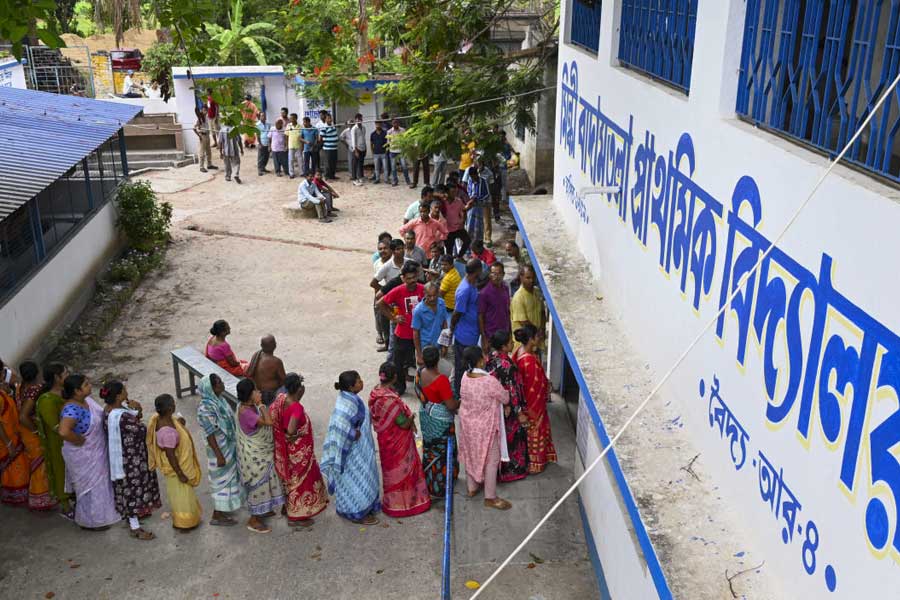What’s common to Mamata Banerjee and sari weavers in the Santipur-Phulia cluster of Nadia? Both are troubled by “outsiders”, that too from Gujarat.
If Narendra Modi has been giving the Bengal chief minister a tough fight over the last few years, for the weavers, Surat-made cheap imitations of traditional saris like Jamdani and Tangail are posing a threat to their survival.
Weaved in a variety of yarns like cotton, tussar and silk, Jamdani is an elaborately patterned, traditional handloom woven sari. Tangail — for which Phulia is especially famous — is a sari with designs on its borders.
Imitations of these traditional items are being manufactured with the help of technology in Surat, the commercial capital of Modi’s Gujarat, and supplied in abundance to weavers every week.
Though the Surat saris are inferior in quality, with thousands of saris reaching Santipur-Phulia every week, customers are picking up the attractive yet cheap imitations.
On Monday, when the 50,000 and odd weavers and their families go to the polling stations to elect a representative for the Ranaghat Lok Sabha constituency, they would only expect at least one “gift” from the winner — to stop the entry of the “outsider” to their hub.
“Very few people come to us to buy the real ones. Those are costlier. So everyone rushes for the cheap imitation. Whoever wins this time, we will appeal to them to prohibit the entry of the trucks from Surat to Nadia,” says Samir Pramanik, 51, a weaver in Santipur Kutirpara.
The crisis for the sari weavers began over a decade ago with the entry of power looms, followed by the fast-weaving Rapier machines that can weave at least 15 saris per day. A handloom weaver takes at least one month to make the same number of saris.
But what’s wrong with power loom saris?
Simply put, handloom saris are softer in texture with extra thread on the pallu and more resilient than powerloom-made saris.
Moreover, the power loom saris are hard and do not drape well. The intricate and exquisite designs of handloom saris like Jamdani cannot be matched and certain types of weaving patterns are only possible on handloom saris.
The weavers’ trouble is three-fold — power loom, Surat’s cheap synthetic version and poor wages.
While the making cost of a basic standard Jamdani is around ₹2,000, the imitation synthetic version is sold at a throwaway price of just ₹600 in the retail market.
Also, the stagnant wage of the weavers is a major disincentive.
At present, a skilled weaver who can weave a maximum of 20 saris a month can earn ₹4,000 as gross wage per month at an average of ₹200 per sari. Wages generally range from ₹120-200 per sari. For an intricate design, a weaver can earn a few hundred rupees more.
With cotton thread, a weaver said, he can make an export quality taant sari in two days with a gross manufacturing cost of ₹1,200. But for this, he gets only ₹300 as wage.
“By making around 20 saris a month on average, my income seldom crosses ₹4,000. There has been no change in wages for several years. With such a paltry income it is difficult to survive with five family members,” says Pramanik. “The situation has forced many weavers to migrate in search of other trades. I joined the trade 35 years ago but I have told my graduate son to try his best for a job so that he is never compelled to
join this.”
The Bengal government has lent support with the “Biswa Bangla” branding across the country but the weavers are no better off — many of them are compelled to dismantle their handlooms every year and become migrant workers.
But despite all this, many weavers and cooperatives are trying hard to carry forward the legacy of Santipur-Phulia.
Padma Shri-awardee weaver Biren Basak is among the few who can offer good wages for the art and the artists to sustain.
“I can do little with my limited effort. But I do it out of my responsibility for the survival of the art and the sustained development of the artists. Paying higher wages will make my products costly but I prefer to take this risk,” Basak, who works with 8,000 weavers, told The Telegraph.
“The day is not far away when the handwoven taant saris of Santipur-Phulia will permanently take place in the pages of history,” rues 62-year-old Swadesh Pramanik, now manager of the Santipur Kutirpara Cooperative Weavers’ Society Ltd.
“Once where there were 2 lakh land weavers, now only about 50,000 weavers are struggling to keep the legacy alive.”
Arun Basak, a leader of the Trinamool-affiliated INTTUC in Santipur, acknowledges the bleak future.
“It is true that Mamata Banerjee is eager to develop the area. She wears saris from Phulia and promotes them as well. But it is difficult for her to stop saris from Surat arriving in Nadia. Plus, she has little role in improving the wages as it is controlled by the cooperatives and the individual manufacturers, who are afraid of a further fall in demand if the price of handloom saris goes up due to increased wages,” says Arun Basak.
Says sitting MP and BJP candidate, Jagannath Sarkar: “The Centre has launched many welfare schemes for the benefit of weavers and also introduced identity cards to ensure financial support for them. At the same time, we are trying to link them with the market, avoiding the middlemen, which will increase their income.”
While the state government offers marketing support and help in entrepreneurship and skill development, weavers want the prohibition of “outsiders” from Gujarat and an intervention for increased wages.
Biren Basak proposes the mandatory use of the traditional saris of Santipur-Phulia by teachers in the state government’s schools and colleges. “It will ensure a regular income flow for the weavers,” he explains, adding: “We need to save our tradition from the invasion of outsiders.”
Ranaghat votes on May 13











